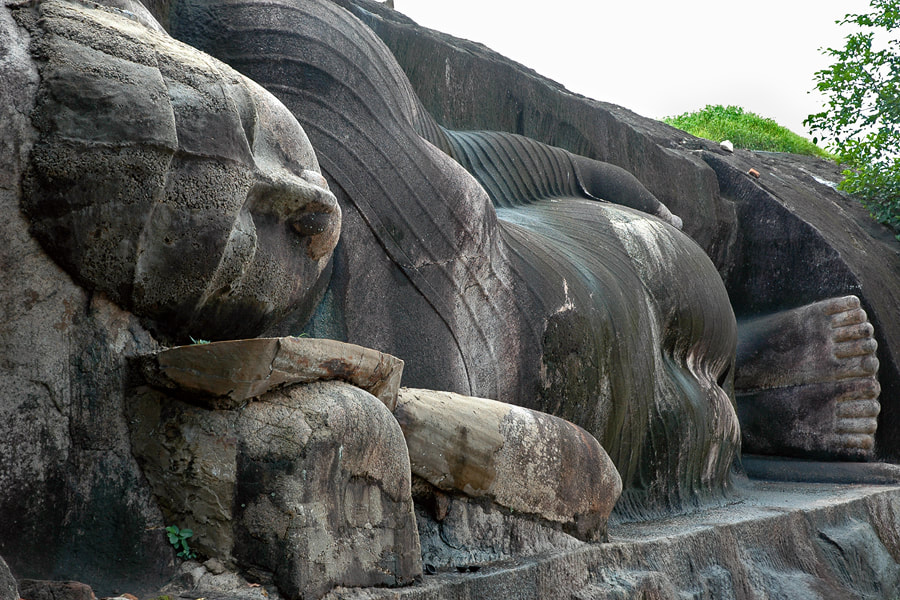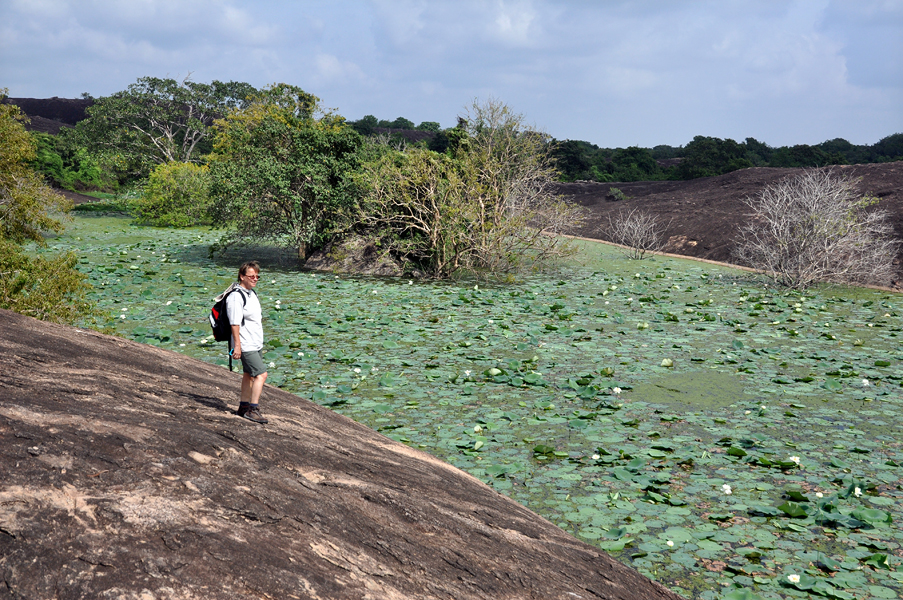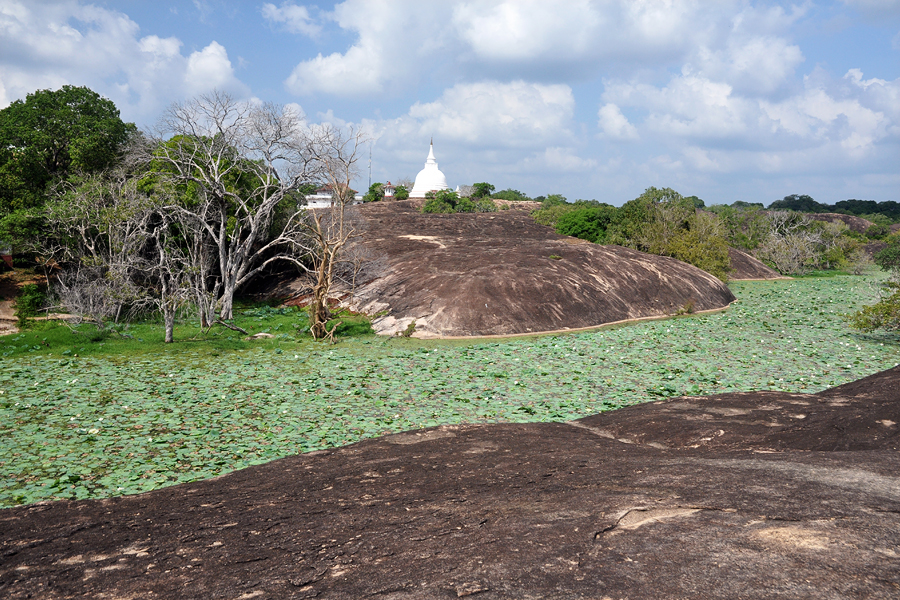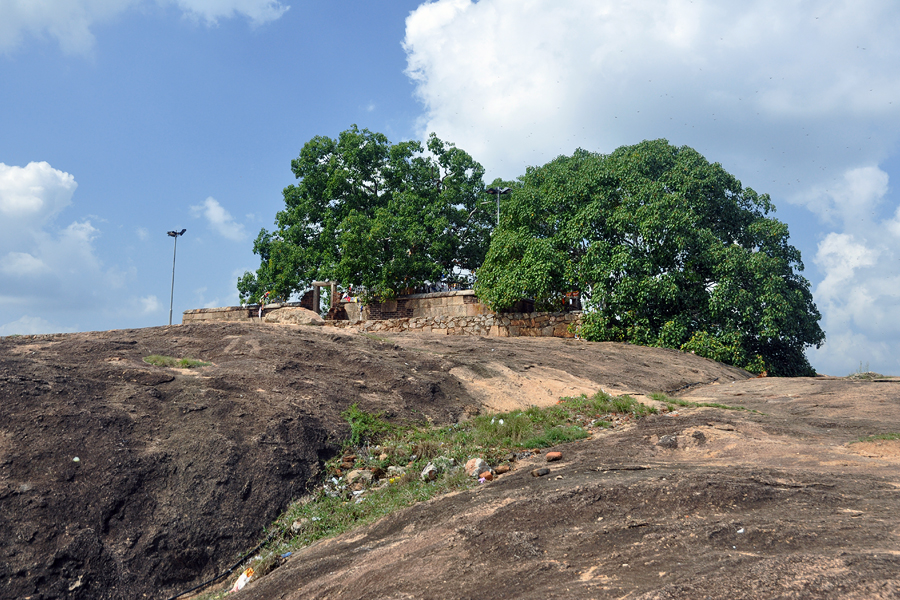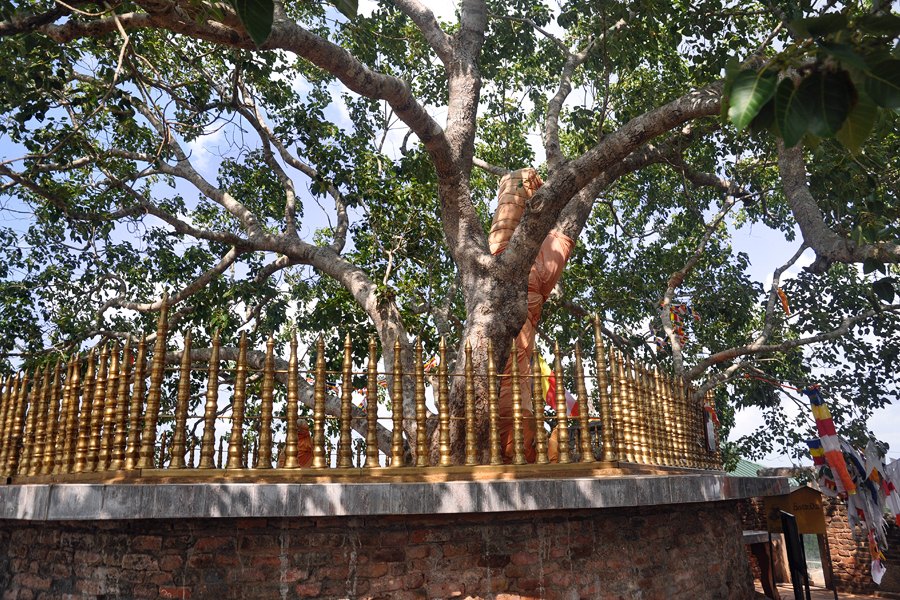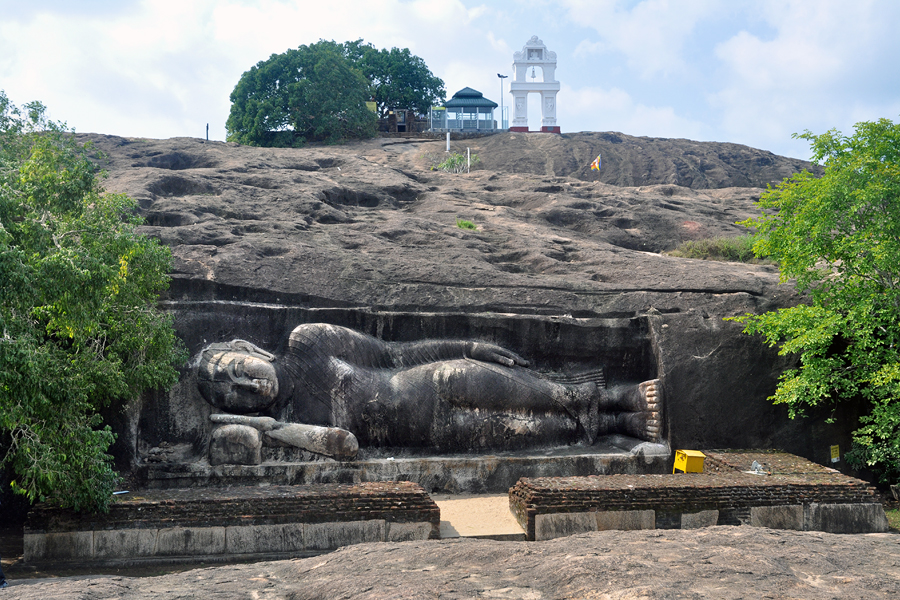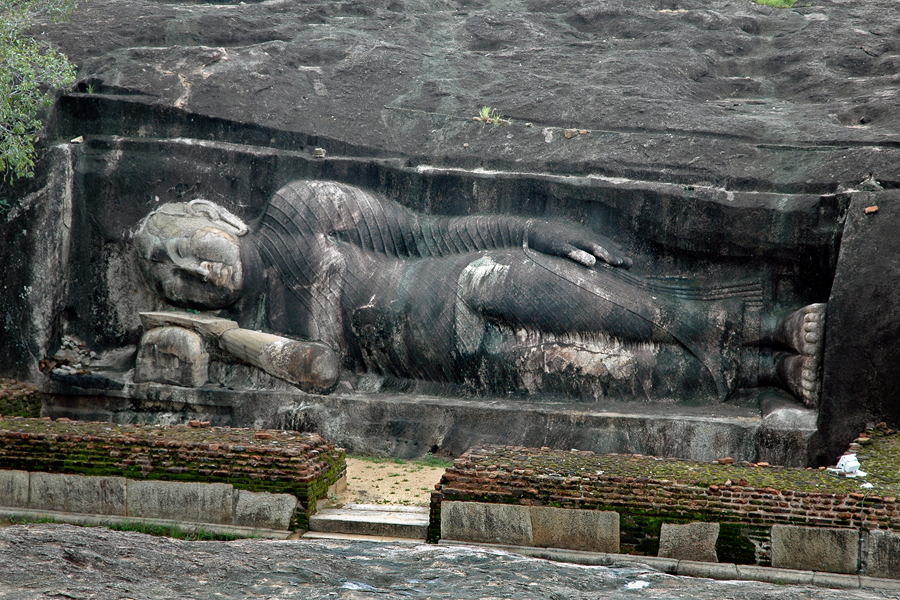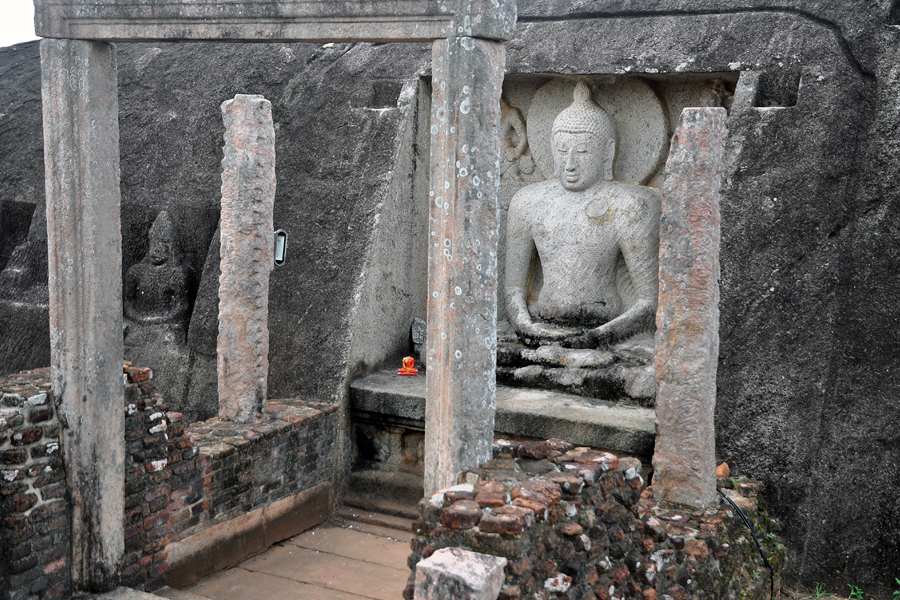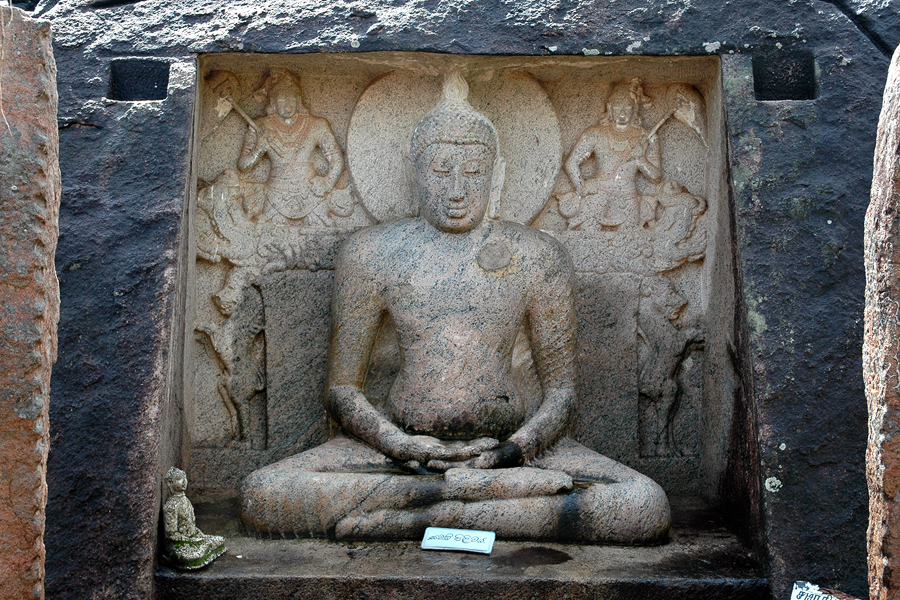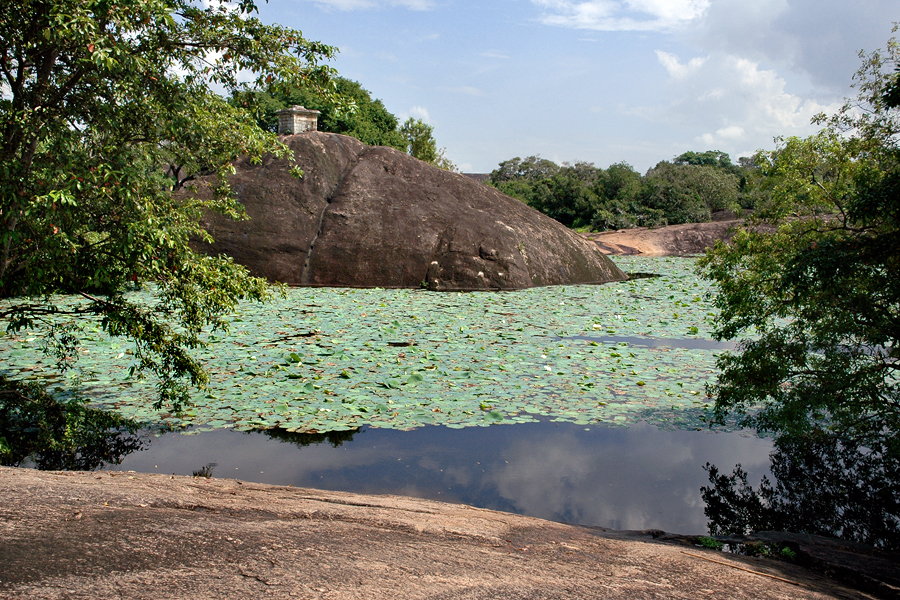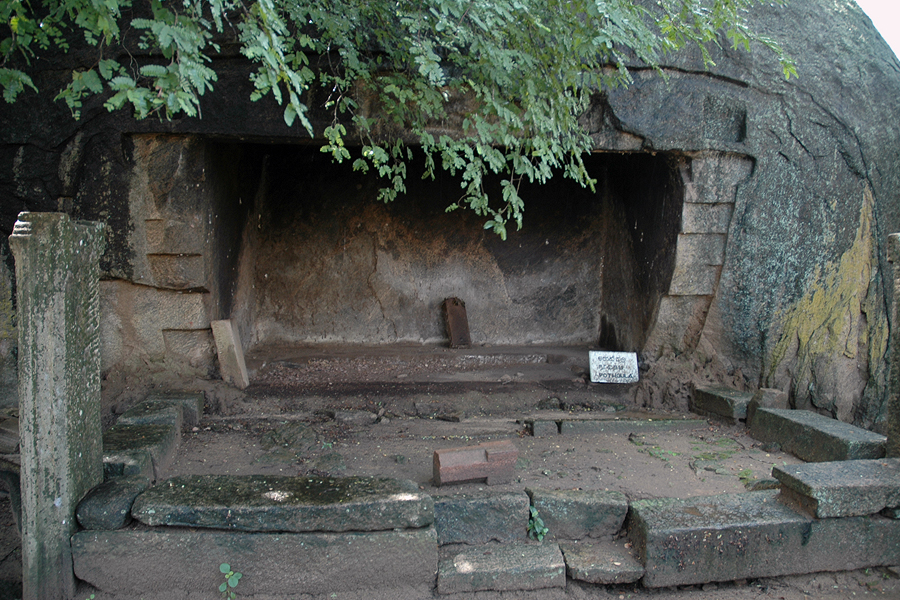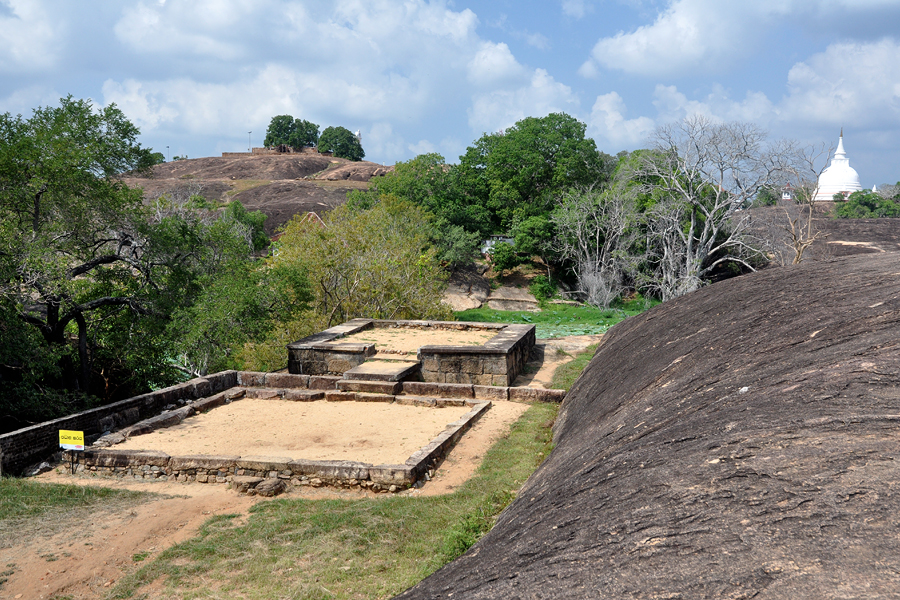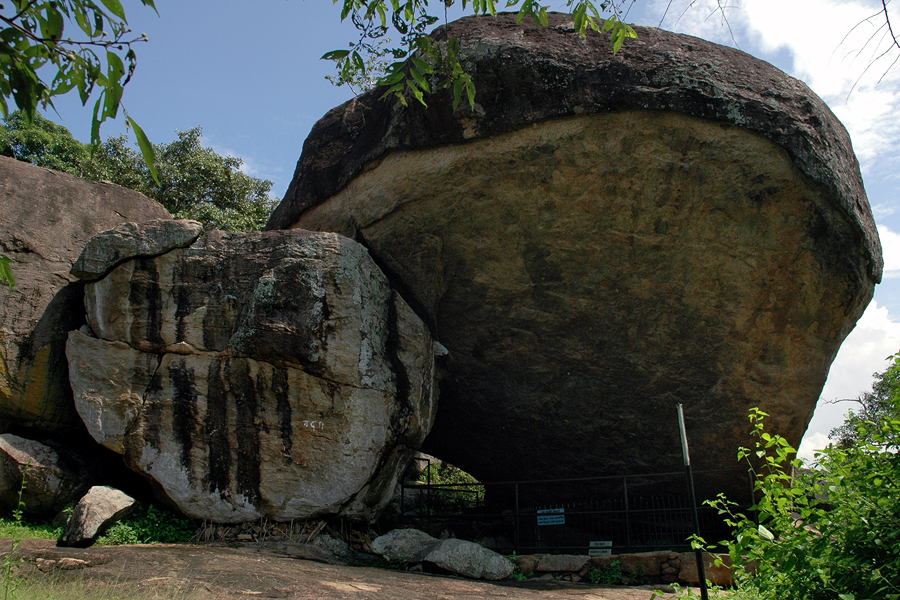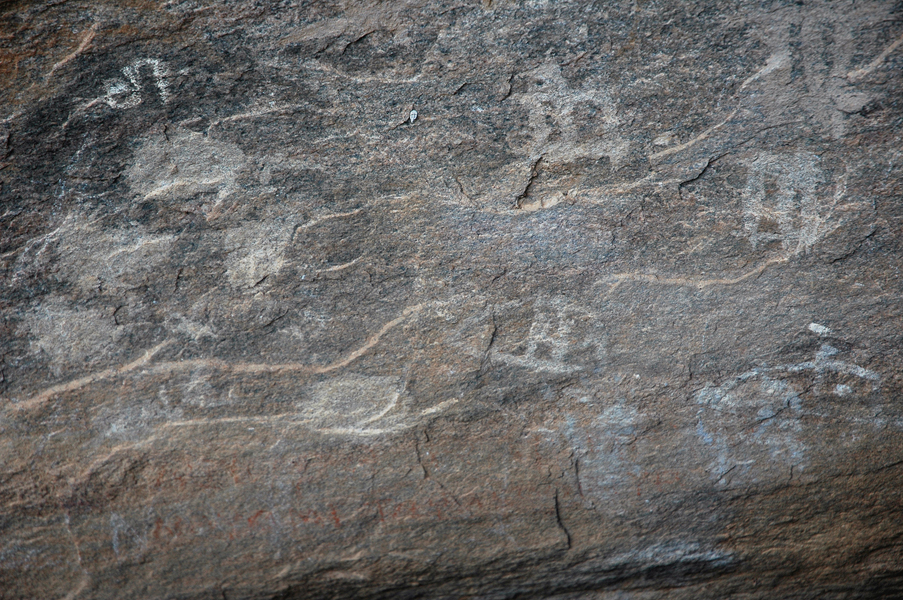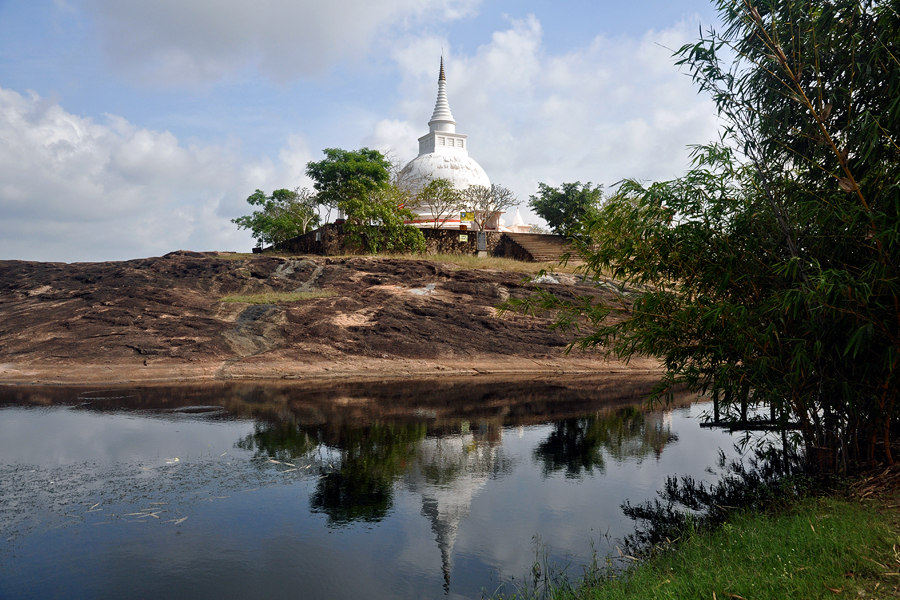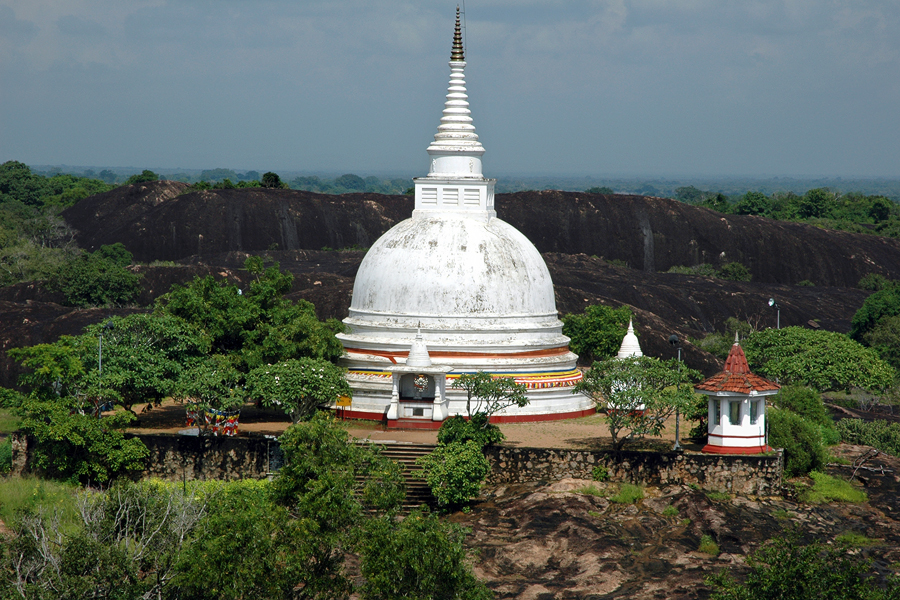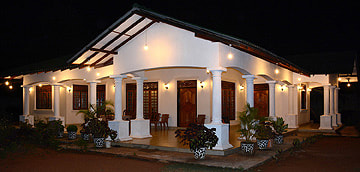Thanthirimale has become a popular place of pilgrimage among the Sinhalese Buddhists in recent years. For foreign travellers, this heritage site remains to be an off-the-beaten-track destination. There are at least three very different kinds of attractions in Thanthirimale for today’s visitors. Second only to the Bo-Tree of Anuradhapura, the Bo-Tree of Thanthirimale is held in high esteem as miraculously surviving in an inhostible surounding till the present day. Second only to the rock statues of Polonnaruwa, the reclining Buddha of Thanthirimale ist one of the three large rock-cut sculpture in this posture from the island’s ancient period. Furthermore, Thanthirimale is a prehistoric site. One of the few examples of ancient Veddah tribe paintings can be found in some of the rock shelters of Thanthirimale.
Content of this Thanthirimale page:
general information: Location - Scenery - Name - History
what to see: Bo-tree - Reclining Buddha - Seated Buddha - Lotus Pond - Library - Prehistoric Paintings - Dagoba
excursuses: Love Story of Prince Saliya and Ashokamala - Mahavamsa quotes: on Ashokamala - on Tivakka
general information: Location - Scenery - Name - History
what to see: Bo-tree - Reclining Buddha - Seated Buddha - Lotus Pond - Library - Prehistoric Paintings - Dagoba
excursuses: Love Story of Prince Saliya and Ashokamala - Mahavamsa quotes: on Ashokamala - on Tivakka
Scenery of Thanthirimale
Gently undulating like a wave, the granite hills of Thanthirimale are inviting to stroll around in the rocky terrain of this ancient site, just to enjoy the serenity and tranquitlity of this pleasant place. Walking around to find caves and ruins is a pleasant experience here, because Thanthirimale remiained to be a widely undisturbed heritage site. Sprawling extensive boulders spread over one square kilometre. The core area of the ancient site covers about 20 hectares. The surroundings are covered with shrub jungles. The area is surrounded by Malwatu Oya and Kanadara Oya by three sides. But in the 20th century, the Thanthirimale area was starkly depopulated due to its lack of water and the salty soil.
Not surprisingly, the panoramic site in of Thanthirimale is believed to be the setting of Sri Lanka’s best-known love affair. Part of the story is, that this abode of a hidden couple finally became their granted small “kingdom of love”:
History of Thanthirimale
Tantirimale is situated halfway between Anuradhapura and the island of Mannar, at the river Malwattu Oya which is connecting the ancient Sinhalese capital with Mantota near Mannar. Mantota, then known as Mahathitta, was the principal port for the Anuradhapura kingdom. This area also had also been the landing place of the first Sinhalese settlers, the followers of Prince Vijaya, who arrived on the islan which he called Thambapanni about 500 B.C.E. Thanthirimale, located upstream, definitely became one of the first Sinhalese villages on the island. Some believe it to be the ancient Upatthissagama mentioned in the chronicles. When Prince Vijaya ordered his followers to establish settlements in different areas, Upathisssa was one of his ministers. The village named after him was the first Sinhalese village and became a commercial city later on and it played an important role in early Sinhalese history.
The Dipavamsa and Mahavamsa chronicles describe the events under the reign of King Devanampiya Tissa, when the Buddhist order was established on the island, in much detail. They record that soon after the introduction of Buddhism by Thero Mahinda from India the Bo-sapling was brought from India to Sri Lanka by his sister, the nun Theri Sanghamitta. The chronicle mentions, that the Indian delegation and their Sinhalese welcome group rested on their way from Mantota to Anuradhapura at “the village of the Brahmin Thivakka” . As a token of appreciation of the hospitality of the Brahmin, an offshoot of the Bo-sapling was later on sent to him, after the sapling had been planted in Anuradhapura. Presumably, ever since Thanthirimale had been inhabited by reclusive monks. When Saliya, the only son of the famous king Dutugemunu, was expelled from the royal family for the reason of falling in love with a girl from a lower caste, the loving couple took refuge in a remote region which is believed to have been Thanthirimale. The golden era of Thanthirimale began in the late Anuradhapua period, about 700 C.E, when the Thanthirimale Raja Maha Vihara seems to have developed from a small temple to a large monastery. But most probably, the rock images date from the heydays of the Polonnaruwa period in the 12th century. In the middle of the 13th century, the monastery was destroyed by the marauding invader Kalinga Maga. The place fell into decay and was unidentified till the 19th century. After its rediscovery, it remained abandoned till 1960, when Kudakongaskada Vimalagnana Thero, a 23-year-old Buddhist monk from the nearby village Ulukkulama, settled in Thanthirimale in order to resuscitate this place of worship. A stupa and an image house were constructed and a small Archaeological Museum of Thanthirimale was established, too. Many stone containers originally created to contain relics and precious adjubts had been scattered around the monastery premises and are now exhibited at the museum. Some Nagaraja statues can be seen in the museum, too, one of them nine-headed. In 1990, the LTTE guerilla attacked this area and killed several persons. In 1992, they assassinated the chief incumbent. Venarable Thanthirimale Chandrarathana Thero became the successor. During the Poson month celebrations 2007, Thanthirimale was officially declared as a Sacred City by the Sri Lankan government. Bo-Tree of Thanthirimale
The Bodhi tree of Thanthirimale is perched on top of the flat rock. For today’s Buddhist pilgrims, this Bo-tree is definitely the most sanctified object of veneration in Tantirimale. The Bo tree is surrounded by a dry stone wall. This structure is called a Bodhighara. “Bodhi-ghara” means “Bodhi(tree)-shrine”. The Bodhighara was restored with the original stones that were found in situ on top of the large stony layer. After the restauration of this wall surrounding the tree, Thanthirimale has Asia’s only ancient Bodhighara with its original tree still existing.
The tree is said to have smaller leaves than usual, due to the lack of water and the high concentration of salt in the soil. That this tree survived so many centuries at such an exposed place, without wind shelter, lacking fertile soil, is regarded as a miracle by pious Buddhists. That’s one more reason why Thanthirimale has the second most sacred Bo-Tree on the island. Even after the conversion of King Devanampiya Tissa and Anuradhapura’s people to Buddhism, Thanthirimale seems to have remained a Brahminic place. When King Devanampiyatissa first visited the temple in Thanthirimale, it was known by another name. The Mahavamsa chronicle mentions two times Thivakka Bamunu (or Thivanka Bamunu) and his village, Bamunu being a name for a Hindu hermit. Firstly, on the procession from the coast to Anuradhapura, the Bo-Tree sapling sent by India’s emperor Ashoka was welcomed by Thivakka Bamunu. Secondly, one of the first eight off-shoots of the Bo-Tree, after planting it in Anuradhapura, was sent to Thivakka Bamunu. Thus the Bo-Tree of Thanthirimalee can count nearly 2300 years of existence. A rock inscription near the ancient Bodhi tree is said to confirm that one of the first eight offshoots of the “Jaya Sri Maha Bodhi” (Bo-Tree) was planted at Thivakka Bamunu Gama.
Although the name “Thivakka Bamunu Gama” suggests, the village was the home to a Brahmin called Thivanka, there is a different theory on the origin of the term”Thivakka”, which means “three curves”. The village (gama) could have been named after its location, being surrounded by three curves of the Malwatu river. According to the Mahavamsa, the transfer of the Bo-Tree sapling from the coastline to the capital took several days. Later traditions have it, that it was kept at the village of Bamanu Thivakka, identified as Thanthirimale, one night. For example, the Pali name “Thivakka” is also mentioned in a chronicle of the late Anuradhapura period (10th century). This chronicle dedicated to the history of the Bo-Tree is named after this sacred Tree: Bodhivamsa or Mahabodhivamsa, Bodhi being an abbreviation for “Bodhi-Tree” (“Bo” again is an abbreviation of “Bodhi) and “Vamsa” meaning “Chronicle”. The Bodhivamsa is a prose poem in elaborate sanskritized Pali, composed during the reign of Mahinda IV. The Bodhivamsa quotes verses from the Mahavamsa, which was written in the 6th century, but draws a great deal of its material from other sources, too. Furthermore, there are folk legends connecting the Bo-Tree of Thivakka in today’s Thanthirimale even more closely with the original one that arrived from India. One version of the story says, that the Brahmin visite the Bo-Tree in Anuradhapura himself and from there returned with an off-shoot in order to plant it in Thanthirimale. Another version has it, that when the Bo-tree, on its transport to Anuradhapura, was kept in Thanthirimale for a while, one branch separately grew from the pot and was planted here to remember the incident. In consequence, the planting of the Thanthirimale Bo-Tree would have taken place even earlier than the planting in Anuradhapura. Hence, some believe that the Bo-Tree in Thanthirimale may well be the very first Bo-Tree in Sri Lanka at all. Reclining Buddha of Thanthirimale
At the northern foot of the same rock, facing the Dagoba, is an enormous image of recumbent Buddha. This is the main attraction for heritage tourists in Thanthirimake. The scupture is carved on the steepest part of the northern slope of the rock. The reclining Buddha of Thanthrimale measures 14 m (45 ft) in length and is cut 2 m deep into the rock. It’s less spatial than the Sri Lanka’s most famous reclining Buddha, that of the Gal Vihara in Polonnaruwa. And the fall of the falts of the robe is less elaborated than in Polonnaruwa.
Originally the recumbent Buddha of Thanthirmale was protected by a roof and lying inside an ancient image house. The roof and its stone pillars disappeared centuries ago, exposing the statue to weathering, but the worst damage had been done by treasure hunters. The statue was severely damaged by treasure hunters who had burrowed into the ruins in search of treasures and blew up the face of the Buddha statue with dynamite. Although the Samadhi statue is now restored by Sri Lanka’s Department of Archeology, the result cannot be satisfactory, as the original face is lost forever. There are two different datings of the recumbent Buddha of Thanthirimale. Most likely, it’s from the late Polonnaruwa period. This would correspond to the theory that it remained unfinalized, since the artists and workers fled, when the troops of the invader Kalinga Magha marauded on the island and destroyed the Polonnaruwa Kingdom. The reclining Buddha of Thanthirimale seems to be a parochial and degenerated copy of the much more elaborate recling Buddha of the Gal Vihara in Polonnaruwa, which is most probably a work of the Polonnaruwa heydays, the reign of Parakramabahe the Great in the second half of the 12th century.
Nevertheless, some historians dated back the Thanthirimale Buddha to the late Anuradhapura period for stylistical reasons. The body is more symmetrical than that of the Gal Vihara sculpture and its contemporary copy in Bakamuna, the Attaragollava Buddha. For example, the contours of the legs under the garment are equal in width, whereas the underlying leg of the reclining Buddha in Polonnaruwa is slightly pushed in. The waiste is less distinct and it’s also symmetrical, in contrast to the reclining Buddhas of Gal Vihara and Attaragollava with their left waistes cut deeper, more similar to a relaxed lying human being. All in all, the reclining Buddha on Thanthirimale seems to be similar to a standing Buddha laid down in a horizontal line. The stylistical similarities to standing giant Buddha statues in Aukana and Sasseruwa are the reason why some art historian date the Thanthirimale Buddha to the same period as those standing Buddha, the 9th or 10th century, instead of the Polonnaruwa period. Sedentary Buddha of Thanthirimale
The sedentary Buddha statue carved into the rock face is 2.2 m in height. It is called Samadhi Buddha due to its meditating posture known as Dhyani Mudra or just Samadhi Mudra. Stone pillars in front of the sedentary statue indicate that the seated Buddha statue was once sheltered by a roof. Similarly to the reclining Buddha, the statue was in the interior of an image house. There are more pillars and carved stones scattered around the site.
Next to the Samadhi statue, four other figures have been carved into the same rock surface. Niches with uncompleted roughly marked torsos of deities. The unfinished state of the images could indicate that site wasen abandoned by the craftsmen in haste, maybe due to foreign invasions. Behind the image of the sedentary Buddha is a dragon arch similar to those that can be seen behind the seated Buddha inside the Vidyhadhara Guha cave of the Gal Vihara in Polonnaruwa. Like in Polonnaruwa, attendants holding flywhisks can also be seen. Flywhisks, called “chamara” or “prakirnaka” are common symbols in Tantric forms of Buddhism, sweeping away obstacles to enlightenment. But in ancient India, they were an emblem of royalty and souvereignty, too. The statue is also decorated with the images of two lions and two Makara-crocodiles.
Lotus pond of Thanthirimale
Descending from the granite hill with the Bo-Tree and the Buddha statues, the visitor arrives at a lotus pond, contributing much to the quaint atmosphere of the setting of Thanthirimale.
According to local belief, this pond never rund dry. Indeed, it’s an artificial little tank formed by an embankment built from rock to rock.
Library complex of Thanthirimale
Behind the lotus pond is a cluster of caves and ancient structures. Inscriptions in ancient Brahmi script can be found at the caves. An artificial niche is identified as a Pothgula, a so-called library. Library room of a Buddhist monastic complex was not a study room but a repository for palm-leaf manuscripts of sacred texts and for other ritual objects. A stone structure in the niche appears to have been used for rituals.
Just in front of the library cave is a building in the form of a double-platform. These structures are Padhanagharas. They are typical for forest monasteries of a specific group of reclusive monks called Pamsukulikas. This group came to existence in the 6th or 7th century. They built their own monasteries in the 8th to 10th century. This indicates, that Thanthirimale served as a forest monastery during the late Anuradhapura period. But is does not mean, that this monastery was not inhabited by other monks than Pamsukulikas. About a dozen Padhanagara meditation platforms and meditation can be found in Thanthirimale scattered over 100 hectare. Some of them were surrounded by water and were also used for punitive rituals. Five medition in this area were inhabited already in the first century B.C.E, Brahmi inscriptions mention the donors.
Prehistoric cave paintings of Thanthirimale
Pre-historic drawings can be found in two adjacent caves, which are situated 500 m west of the library compex and can be reached on a small jungle track. The caves at Tantirimale had been inhabited prior to the recorded history of Sri Lanka’s ancient Sinhalese civilization. The murals are said to be left by the aboriginal inhabitants of the island, predecessors of today’s Veddah tribes (Wedda people). These drawings are assumed to be almost 4000 years old. There are stylized depictions of feline preditors and deer and of heavenly bodies such as sun and moon. Some symbols seem to have been pictogramms, precursors of writing characters. The first cave is 6.50 meters wide and extends up to 3.75 meters high. The second cave, situated on the rear side of the same rock, is 3.60 meters in width and 3.70 meters in height.
In 1909, John Still, assistant of the then Archaeological Commisioner H.C.P. Bell and author of the celebrated book "The Jungle Tide", discovered archaeological evidence from the surface layer. “In prehistoric times it must have been the refuge of human beings, for in it I found fragments of cherts and a piece of crystal. These were not in any sense implements, but they may have been waste chips thrown away while implements were being made for they are of material quite foreign for their surroundings”, he wrote.
Dagoba of Thanthirimale
It is not known whether a dagoba existed in Thanthirimale in antiquity. A modern dagoba was built on the summit of granite hill in 1976. The white dome of the stupa contrasts picturesquely with the dark colour of the boulder.
To the left of the dagoba is a newly-built image house, too. The modern shrine of the Thanthirimale temple was begun in the 1970s and contains many colourful wall paintings.
|
Name of Thanthirimale
The official name of the monastery is “Thanthirimale Raja Maha Vihara” or “Thanthirmale Rajamaha Viharaya”. There are many different spellings of the site’s name. “Tantirimale” is very common, “Thantirimale” and “Tantirimalai” or “Tantrimale” can also be found. The second part of the name “-male” is derived from the common Indian word “malai” for “hill”. “Thantiri” my refer to “Tantra”, a specific form of Buddhism which is uncommon in Sri Lanka. However, there is a much more poetical etymology of the name “Thanthirimale”. “Male” can mean “ “necklace” in Sinhala, and “Thanthitiya” is the name of a common butterfly”. The interpretation as “butterfly necklace” refers to an episode of a much beloved story. The namegiving golden necklace in the shape of the butterfly, a gift of King Dutthagamani, is believed to have been enshrined in the rock of Thanthirimale by Ashokamala, wife of his son, Prince Saliya.
Sri Lanka's little Kingdom of Love
The reason why the quaint hills of Thanthirimale earn the title "Kingdom of love" is the belief that it once was the setting of the island's most popular love story, the legend of Prince Saliya and Ashokamala.
|
Location of Thanthirimale
The ancient site of Thanthirimale is situated in a remote dry-zone area at the border of Wilpattu National Park, 37 km northwest of Anuradhapura.
